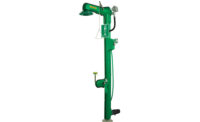
To the credit of industry, there are literally hundreds of thousands of emergency drench shower and eyewash installations throughout the U.S. During the past 40 years or so, senior business managers have increasingly embraced the principles of safeguarding their workforce and providing the utmost in first aid for those who fall victim to on-the-job injury. While an argument could be made that at least some of the rise in awareness is due to regulatory pressure, the undeniable fact is that today’s sensitivity is morally correct and simply good business.
In effect, it’s a “protect others as you would have them protect you” mentality. But for those who still require regulatory motivation, the American National Standards Institute (ANSI) maintains specific guidelines covering emergency response equipment, including drench showers and eyewashes.
Just what is a “tepid†flush?
As an emergency equipment manufacturer, we have noted an interesting dynamic with respect to acceptance of certain more recent changes in the ANSI response protocol, most notably tempered water.In its 1998 revision, ANSI Z358.1 included a general requirement that flushing fluid be “tepid.” Definition of that early requirement was left somewhat vague, leading to individual interpretation of the term. It can mean different things to different people, apparently including the acceptability of municipally supplied water at the temperature it arrives through the wall of the facility. Source water supply temperatures in most areas can be quite chilly, especially after they’ve run for awhile. This uncomfortable chilling can lead to cessation of the drench or irrigation cycle prior to the 15-minute requirement established by ANSI or even hypothermia for those brave souls tough enough to withstand the cold.
Tepid defined
In its subsequent 2004 revision, ANSI further clarified the definition of “tepid” to be in the range of between 60ËšF to below 100ËšF. Output flushing fluid must be within that range at start-up of the equipment and remain there throughout the full 15-minute use cycle.In the face of this now crystal clear definition, there seems to be some inertia within the industrial safety community in embracing the required changes. Make no mistake, more and more tempering equipment and turn-key systems are sold every day. Business is good. But at today’s level of activity, it will take years to reach even marginal compliance given the total volume of emergency showers and eyewashes that are installed throughout the country. It is, in our opinion, important for users to understand that a very specific requirement is in place and local interpretation is no longer acceptable.
Significant risks
There are two significant risks in delaying addressing the need for tempering capabilities:- Most obvious is compliance to the Z358.1 requirement. We’ve noted a marked increase in the size of the fines levied by OSHA in the past months. While most of these punitive measures involve deviations beyond showers and eyewashes, they could be levied on single instances alone. Fines of this magnitude can often represent a substantial portion of the cost of the changes needed to comply.
- Beyond the possibility of having your friendly OSHA representative become less friendly as a result of finding you in violation of the requirement, the clarity of the temperature range requirement could be a solid piece of evidence in a negligence law suit. Consider the possibility of an injured employee short-cutting his or her treatment protocol because the water was too cold. If a court determines that the employee sustained an injury that could have been at least partially avoided had he or she remained engaged with the shower or eyewash for the full required period, it could lead to catastrophic consequences.




